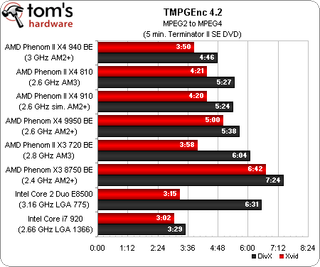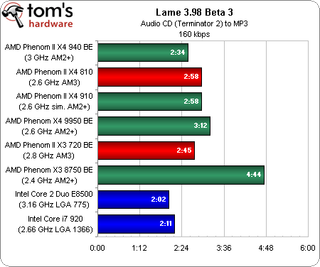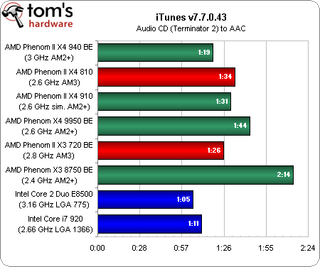Socket AM3: AMD's Phenom II Gets DDR3
Benchmark Results: A/V Encoding

The A/V tests are, in general, a bastion for Intel's Core i7. Starting with Mainconcept, the i7 920 quickly asserts itself as the quickest chip in our lineup. AMD's quad-core processors perform admirably, though. The Phenom II X4 940 finishes the test in 2:15, followed by the X4 810 15 seconds later (and ahead of our simulated 910, in fact). AMD's Phenom X3 720 BE improves on the X3 8750's score by not only turning up the clocks, but also incorporating extra cache.

Intel shines yet again in TMPGEnc. Scaling across AMD's lineup roughly matches the Mainconcept results in the DivX encoding batch. However, Xvid shows the 2.8 GHz Phenom II X3 720 creaming most of the quad-core chips, since it doesn't run across four threads. With Windows' performance monitor running, we noticed that the Xvid task was only really registering about 30% CPU utilization on the X3, though.

Another benchmark more sensitive to clock speed than threading, Lame sees the Phenom II X3 turning in more impressive numbers than most of the quad-core chips from AMD's lineup.

The same situation repeats itself during our iTunes benchmark.
Stay on the Cutting Edge
Join the experts who read Tom's Hardware for the inside track on enthusiast PC tech news — and have for over 25 years. We'll send breaking news and in-depth reviews of CPUs, GPUs, AI, maker hardware and more straight to your inbox.
Current page: Benchmark Results: A/V Encoding
Prev Page Benchmark Results: Productivity Next Page Benchmark Results: Crysis And Far Cry 2-
groo I sure don't see the point of spending cash on DDR3 unless you are also spending cash on i7. I woudn't mind a CPU that can handle DDR3 in the future, but there sure isn't a reason toupgrade to it at today's memory prices.Reply -
Aatish nice review... but....Reply
strangely AMD is performing better than core i7 920!
what did I miss? in previous benchmark done by you guys showed AMD performing quite less than what I see in this benchmark! can anyone clear my confusion? please!:) -
Commlock Very good test indeed that shows, IMHO, to go with an overclocked Core i7 if DDR3 is to be preferred. Otherwise, sticking with DDR2 RAM, an AM2+ MoBo and A Phenom II 940-like CPU seems the best optimized system. However, concerns can be put forward on the continuity of the system in couple of years' time, where simply upgrading without major component changes can be discussed.Reply -
I understand the fact that you guys compare cpu's in the same price region plus whats available to you and the socket upgrade and all that. But i would really like to see how the AMD 940 Black Edition compare to Intel Corei7 EE 965. And maybe include the corei7 940 to. An all out performance battle with just the benchmark figures that countsReply
-
waffle911 ReplyThe 940 runs at 3 GHz. The 920 and 720 both cruise at 2.8 GHz. But the 910, 810, and 710 all run at 2.6 GHz. There goes the idea that each increment of 10 corresponds to 100 MHz. The 805 chugs along at 2.5 GHz.
Looks to me like every increment of 10 in the designation yields a 200MHz clock increment, and 5 being 100MHz. But then either the 940 should actually be the 930. Then again, Volvo's recent product nomenclature doesn't add up, either. the V50 is the wagon variant of the S40, and the V70 was the wagon variant of the S60, but is now of the new S80. But they can't change it to V90 because then the Cross-Country variant of the V70 would have to be called he XC90 instead of XC70—but they already have an XC90 SUV. Digging themselves into a hole of consumer confusion, AMD and Volvo both.
But why is AMD shafting early adopters by shutting out AM2+ PhenomII from the AM3 platform without even offering an AM3 920/940? -
Well, can't agree with socket chart.Reply
Let's see (long run)
AMD&Intel: Socket 7 (intel up to some 266MHz?, AMD up to 550MHz)
Intel Slot 1 - with FCPGA adapters up to some 1200MHz?
AMD SlotA - with socketA adapters up to some 1600MHz?
PPGA s370 ~ 600MHz?
FCPGA (coppermine) 1100MHz
FCPGA2 (tualatin) 1500MHz?
Guess what...PPGA/FCPGA/FCPGA2 were the same socket (s370).
Now...SocketA ranged from 800MHz Durons to 2GHz AthlonXP 3200+
P4 start was with socket 423, but intel soon abandoned it for 478, however there were some adapters for some CPUs which allowed s478 CPUs to work on s423 mobos.
AMD with A64 introduced single channel DDR platform on s754. Later in 939 there was enhancement with dual channel and dual core. But then DDR2 appeared with quite low prices - so they moved to AM2.
Intel brought LGA775, but most chipsets for Prescott couldn't handle Core 2, later C2D FSB800MHz chipsets couldn't handle FSB1066 and 1333MHz C2D/C2Q cpus. And now we get LGA1366, 1156 and some more for the same familly. Well, I guess intel is more disruptive than AMD. I can put PhenomII 810 AM3 to my AM2 mobo on M1695+NF3, some NF3 ASRock users can do that too. AM2/2+/3 is on the best way to be worthy SocketA successor. -
raden_muaz I've been waiting for so long for this phenom ii to come.Reply
At last, phenom beats i7 in some kind of way.
Anyway, I never bought Intel for years because:
http://stopthewall.org/worldwideactivism/982.shtmlhttp://www.inminds.co.uk/boycott-intel.html
-
sohei there are 5 sokets technically but 2 physicallyReply
am2
am2/am2+
am2+
am2+/am3
am3
my question is : somebody try a am2/am2+ with a am3 cpu?
Most Popular


